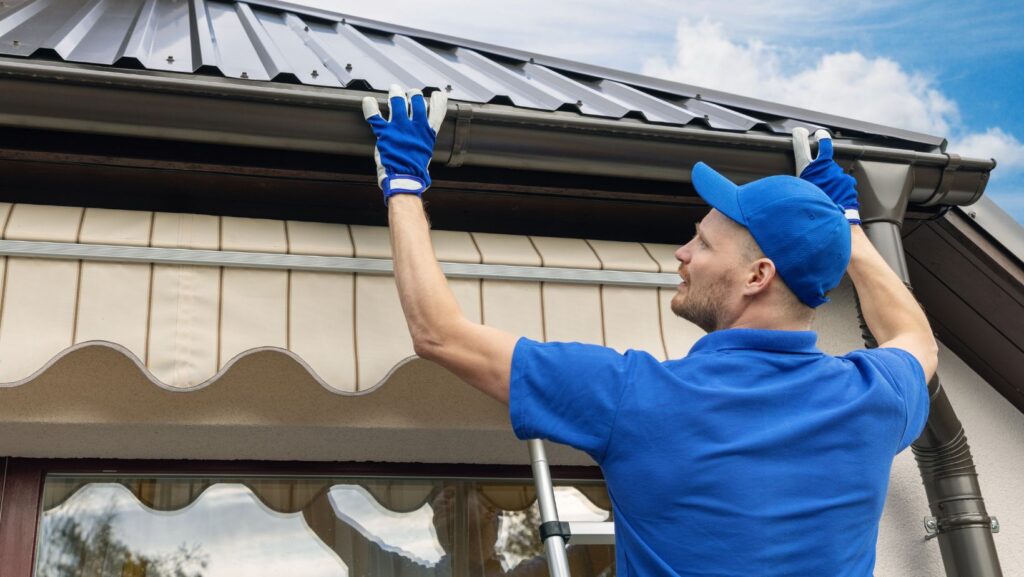
Gutters play a critical role in protecting a home’s structural integrity by managing water runoff effectively. When these systems fail, the consequences can range from minor inconveniences to significant damage to foundations, walls, and landscaping. Identifying warning signs early and addressing them with professional assistance prevents these issues from escalating.
Visible Cracks or Splits in Gutters
Cracks or splits in gutter systems can quickly become problematic and are usually one of the first signs of rain gutter repair being required. While small fissures might seem harmless initially, they allow water to seep through, leading to damage to walls, foundations, and landscaping. Over time, these cracks expand, potentially compromising the integrity of the entire drainage system. Even minor cracks may create pathways for water infiltration into the fascia boards or soffits, accelerating wood rot. Addressing cracks often involves sealing smaller ones with industrial-grade waterproof caulk and replacing sections with severe damage to maintain the system’s overall performance.
Sagging or Pulling Away from the House
Gutters that sag or detach from the house indicate structural issues. This often results from accumulated debris, causing the system to become too heavy to remain securely fastened. When the attachment weakens, water may bypass the drainage system, pouring directly onto the foundation. This issue can also stem from inadequate support brackets or degraded fascia boards. Gutter repair involves reinforcing attachment points with heavy-duty screws and brackets designed to handle additional weight, ensuring long-lasting stability and protection.
Peeling Paint or Rust Spots on Gutters
Paint damage or rust is a clear indicator of prolonged exposure to water or harsh weather. Such issues not only detract from the visual appeal of the system but also hint at persistent moisture problems.

Rusting often signifies stagnant water within the gutter system, which can accelerate corrosion. Specialists typically treat rust by sanding down affected areas and applying anti-corrosion coatings, while repainting with weather-resistant finishes adds an additional layer of protection against future wear.
Water Pooling Around Foundation
Pooled water near the foundation poses a significant risk to the structural stability of a property. This issue often arises when the drainage system is clogged, misaligned, or unable to handle the volume of runoff. If left unresolved, the pooling can lead to hydrostatic pressure buildup, causing cracks in the foundation or basement walls. Solutions often involve realigning downspouts to direct water further away from the home and installing underground drainage pipes to ensure runoff is safely dispersed.
Mildew or Water Damage on Exterior Walls
When exterior walls show signs of mildew, streaking, or water stains, the drainage system is likely malfunctioning. Improper water flow can lead to moisture penetration, causing damage to siding, paint, and insulation. This problem is often aggravated by leaks in the seams or improper slopes in the gutter system. Repairs typically include resealing joints with silicone-based sealants and ensuring the gutters have the correct pitch to guide water efficiently toward downspouts.
Overflowing Water During Rainfall
Overflowing gutters during heavy rain indicate blockages or insufficient capacity. This problem often results from leaves, dirt, or other debris clogging the system. Overflowing water can erode landscaping, damage exterior walls, and compromise the foundation. Professionals frequently recommend installing seamless gutters that minimize clog-prone areas and gutter guards to reduce debris accumulation. Additionally, resizing or adding extra downspouts can improve the system’s capacity to handle high volumes of runoff effectively.
Detached or Broken Fasteners
Fasteners play a crucial role in securing gutters to the roofline. When these components detach or break, the system becomes unstable, reducing its effectiveness in channeling water. Loose fasteners may result from wear, improper installation, or prolonged stress.

Beyond simply replacing fasteners, technicians often inspect the underlying wood for signs of rot or damage and reinforce weak sections to prevent recurring issues. Using stainless steel or aluminum fasteners also enhances durability and resistance to corrosion.
Accumulation of Debris Leading to Blockages
Debris accumulation, such as leaves, twigs, or dirt, is a common issue in many systems. It restricts the water flow, leading to blockages and overflow. To avoid these complications, consider the following steps:
- Inspect and clean the system at least twice a year.
- Install protective guards to reduce debris buildup.
- Trim overhanging branches near the roof.
Professional Assessment and Repair Techniques for Rain Gutters
Experienced technicians address these issues using targeted solutions. They begin with a thorough inspection to identify weak points, leaks, or misalignments. Advanced tools and techniques, such as sealants, reinforcements, or sectional replacements, restore functionality. In some cases, they may use thermal imaging to detect hidden leaks or areas of heat loss caused by water damage.
Recognizing when you need rain gutter repair by professionals can prevent minor issues from escalating into costly repairs. By staying vigilant and seeking timely help, homeowners can protect their property’s structure and maintain its value.







